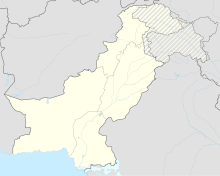Sohr Damb
Coordinates: 27 ° 41 ′ 20 ″ N , 66 ° 18 ′ 30 ″ E
Sohr Damb (also known as Nal ) is an archaeological site in what is now Pakistan , in central Balochistan . It is the eponymous site of the prehistoric Nal culture . The site is about 4 hectares and 13 m high. The four found periods, each with several layers, date from 3800 to 2200 BC. Chr.
Periods
The oldest period (period I) belongs to the cultural complex called Togau . Above all, numerous burials were found. Some of them were housed in small chambers and contained up to 16 skeletons. Ceramic as well as pearls made of semi-precious stones and shells were found as additions.
With period II the Nal culture appears. The dead were now buried in individual graves. There are only a few vessels left as grave goods. Most of the mud brick houses excavated are small. There was a lot of utility ceramics, but also the colorfully painted typical ceramics of the Nal culture. There are also millstones, bone tools, bull figurines and pearls.
Period III is closely related to other cultures in the area ( Mehrgarh , Mundigak in Afghanistan ). The buildings made of clay have now become larger, there is now copper, while the ceramics are simpler. Copper and ceramics were probably processed or manufactured on site.
Period IV is severely disturbed. It belongs to the Kulli culture and the Indus culture .
Digs
The site was discovered in 1903. In the following years, various smaller excavations took place, among others by Sir Aurel Stein . Since 2001, the site has been systematically excavated by the German Archaeological Institute and the Department of Archeology and Museums, Government of Pakistan .
literature
- P. Yule: Silver grave goods from the Sohr Damb near Nal, Pakistan. In: U. Finkbeiner, R. Dittmann, M. Boehmer (eds.): Contributions to the cultural history of the Middle East. Festschrift for Rainer Michael Boehmer. von Zabern, Mainz 1995, ISBN 3-8053-1863-4 , pp. 691-698.
- U. Franke-Vogt: Balakot: Cultural interaction and integration during the early Harappa phase in southern Balochistan (Pakistan). Habilitation thesis. German Archaeological Institute, Berlin 2001.
